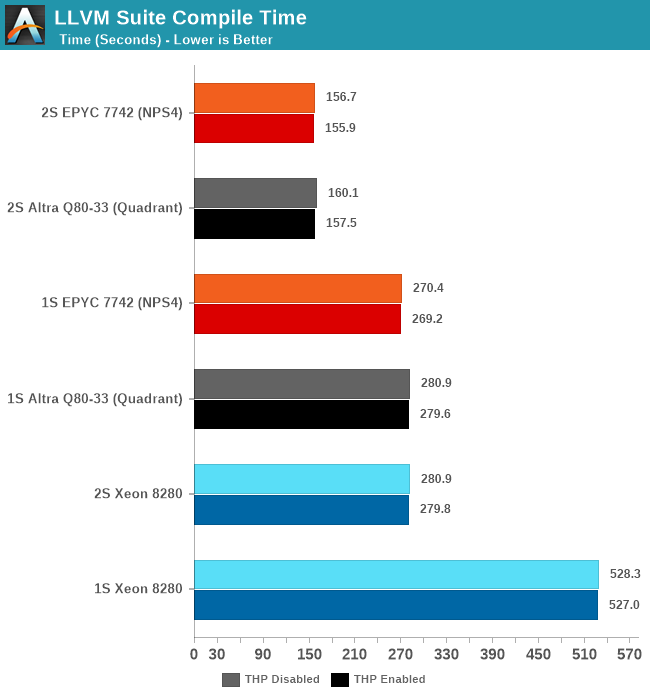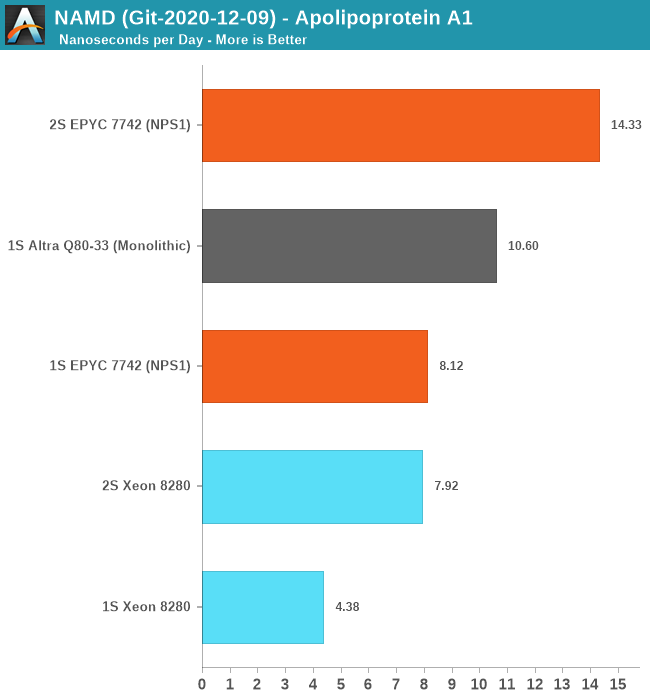The Ampere Altra Review: 2x 80 Cores Arm Server Performance Monster
by Andrei Frumusanu on December 18, 2020 6:00 AM EST- Posted in
- Servers
- Neoverse N1
- Ampere
- Altra
Compiling LLVM, NAMD Performance
As we’re trying to rebuild our server test suite piece by piece – and there’s still a lot of work go ahead to get a good representative “real world” set of workloads, one more highly desired benchmark amongst readers was a more realistic compilation suite. Chrome and LLVM codebases being the most requested, I landed on LLVM as it’s fairly easy to set up and straightforward.
git clone https://github.com/llvm/llvm-project.gitcd llvm-projectgit checkout release/11.xmkdir ./buildcd ..mkdir llvm-project-tmpfssudo mount -t tmpfs -o size=10G,mode=1777 tmpfs ./llvm-project-tmpfscp -r llvm-project/* llvm-project-tmpfscd ./llvm-project-tmpfs/buildcmake -G Ninja \ -DLLVM_ENABLE_PROJECTS="clang;libcxx;libcxxabi;lldb;compiler-rt;lld" \ -DCMAKE_BUILD_TYPE=Release ../llvmtime cmake --build .We’re using the LLVM 11.0.0 release as the build target version, and we’re compiling Clang, libc++abi, LLDB, Compiler-RT and LLD using GCC 10.2 (self-compiled). To avoid any concerns about I/O we’re building things on a ramdisk – on a 4KB page system 5GB should be sufficient but on the Altra’s 64KB system it used up to 9.5GB, including the source directory. We’re measuring the actual build time and don’t include the configuration phase as usually in the real world that doesn’t happen repeatedly.

The Altra Q80-33 here performs admirably and pretty much matches the AMD EPYC 7742 both in 1S and 2S configurations. There isn’t exact perfect scaling between sockets because this being a actual build process, it also includes linking phases which are mostly single-threaded performance bound.
Generally, it’s interesting to see that the Altra here fares better than in the SPEC 502.gcc_r MT test – pointing out that real codebases might not be quite as demanding as the 502 reference source files, including a more diverse number of smaller files and objects that are being compiled concurrently.
NAMD
Another rather popular benchmark tool that we’ve actually seen being used by vendors such as AMD in their marketing materials when showcasing HPC performance for their server chips is NAMD. This actually quite an interesting adventure in terms of compiling the tool for AArch64 as essentially there little to no proper support for it. I’ve used the latest source drop, essentially the 2.15alpha / 3.0alpha tree, and compiled it from scratch on GCC 10.2 using the platform’s respective -march and -mtune targets.
For the Xeon 8280 – I did not use the AVX512 back-end for practical reasons: The code which introduces an AVX512 algorithm and was contributed by Intel engineers to NAMD has no portability to compilers other than ICC. Beyond this being a code-path that has no relation with the “normal” CPU algorithm – the reliance on ICC is something that definitely made me raise my eyebrows. It’s a whole other discussion topic on having a benchmark with real-world performance and the balance of having an actual fair and balanced apple to apples comparison. It’s something to revisit in the future as I invest more time into looking the code and see if I can port it to GCC or LLVM.

For the single-socket numbers – we’re using the multicore variant of the tool which has predictable scaling across a single NUMA node. Here, the Ampere Altra Q80-33 performed amazingly well and managed to outperform the AMD EPYC 7742 by 30% - signifying this is mostly a compute-bound workload that scales well with actual cores.
For the 2S figures, using the multicore binaries results in undeterministic performance – the Altra here regressed to 2ns/day and the EPYC system also crashed down to 4ns/day – oddly enough the Xeon system had absolutely no issue in running this properly as it had excellent performance scaling and actually outperforms the MPI version. The 2S EPYC scales well with the MPI version of the benchmark, as expected.
Unfortunately, I wasn’t able to compile an MPI version of NAMD for AArch64 as the codebase kept running into issues and it had no properly maintained build target for this. In general, I felt like I was amongst the first people to ever attempt this, even though there are some resources to attempt to help out on this.
I also tried running Blender on the Altra system but that ended up with so many headaches I had to abandon the idea – on CentOS there were only some really old build packages available in the repository. Building Blender from source on AArch64 with all of its dependencies ends up in a plethora of software packages which simply assume you’re running on x86 and rely on basic SSE intrinsics – easy enough to fix that in the makefiles, but then I hit some other compilation errors after which I lost my patience. Fedora Linux seemed to be the only distribution offering an up-to-date build package for Blender – but I stopped short of reinstalling the OS just to benchmark Blender.
So, while AArch64 has made great strides in the past few years – and the software situation might be quite good for server workloads, it’s not all rosy and we’re still have ways to go before it can be considered a first-class citizen in the software ecosystem. Hopefully Apple’s introduction of Apple Silicon Macs will accelerate the Arm software ecosystem.










148 Comments
View All Comments
mostlyfishy - Friday, December 18, 2020 - link
Interesting article thanks. One thing I missed, what process is this on? 7nm?It's also interesting that the M1 has demonstrated that with the right sizings, a very wide backend can give you significant single threaded performance. Not really that useful for a server processor where you're likely to be running many threads and want to trade for more cores though.
Josh128 - Friday, December 18, 2020 - link
Yes, 7nm and monolithic, which seems fairly incredible as this thing is huge. Dont have the die size numbers though. Wonder what the yield is on these...Calin - Friday, December 18, 2020 - link
Maybe there are quite a few more than 80 cores on this beast - in which case you can "eat" some die errors by deactivating cores/complexes/...Wilco1 - Friday, December 18, 2020 - link
Each Neoverse N1 core with 1MB L2 is just 1.4mm^2, so 80 of them add up to 112mm^2. The die size is estimated at about 350mm^2, so tiny compared to the total ~1100mm^2 in EPYC 7742.So performance/area is >3x that of EPYC. Now that is efficiency!
andrewaggb - Friday, December 18, 2020 - link
Timing of this article is awkward. We're comparing to the 18 month old 7742 vs the soon to be released Zen 3 Milan parts which based on the already launched Zen 3 desktop parts (and Milan leaks) will be 9-27% faster in the same power envelope.Cache is a big part of the die size for the AMD chip and the N1 has much less of it which makes the die size smaller. AMD's Desktop IGP parts with way less cache perform very similarly in many workloads to those with the extra cache and the same has been true for intel parts over the years. Some workloads don't benefit much at all from the extra cache and some do which makes choosing the benchmarks more important.
That's not to say the N1 isn't more efficient, but rather that it's hard to make a fair comparison, particularly around die size. They may have similar core counts but have made very different design decisions around cache.
Wilco1 - Friday, December 18, 2020 - link
I don't see how it matters, but Altra is about 9 months old and Neoverse N1 is a sibling of Cortex-A76 which has been available in phones for 2 years. As for Milan, I expect the gain on SPECrate to be about 10-15%. And Milan will be competing with the Altra Max which has 60% more cores which should give ~40% speedup.Yes the design decisions are quite different, and it is interesting that they end up with similar performance despite the disparity in L3 cache. I suspect that 8 memory channels is becoming a limit, and a future generation with DDR5 will enable more throughput (and even more cores).
Gondalf - Friday, December 18, 2020 - link
I am sorry but looking carefully the heatsink and the application of the thermal paste, we are facing a limit of the reticle thing on 7nm.We are in front of a 700/800 mm2 thing. On 7nm this means very few units sold and nearly zero market penetration. Same thing on 5nm given the higher core numbers.
In pratics we have nothing in our hands. Another failure in Server market
Andrei Frumusanu - Friday, December 18, 2020 - link
Ampere is doing Altra Max with 128 cores still on 7nm, so this one certainly isn't near hitting reticle limits.Wilco1 - Friday, December 18, 2020 - link
No it is not anywhere near the reticle limit. You can't estimate the die size from the heatsink, but you estimate it based on similar designs for which we do have numbers. Graviton 2 is a similar design at 30B transistors. This has another 16 cores which adds another 16X1.4 = 22.4mm^2. So around 350mm^2 in N7.milli - Monday, December 21, 2020 - link
This is just a ridiculous statement. 350mm^2 ... no way.Firstly, the die size of Graviton 2 is not known.
A realistic comparison would be AMD's Zen2 chiplet which has 3.9b transistors and is 72mm^2.
One would deduce from that, that Graviton 2 is > 550mm^2. Also your napkin calculation to add 22mm2 is flawed. Firstly, you don't know if a N1 core is actually taking 1.4mm^2 in this CPU. Secondly, you're forgetting to add 64 PCI-E lanes.
Let's say, 25mm2 for the CPU and 25mm2 for the lanes. That would bring the total to 600mm^2. Quite a bit bigger to your 350mm^2.